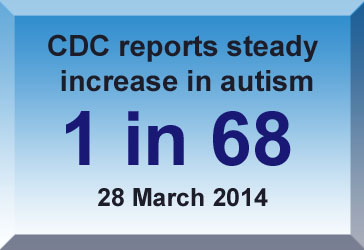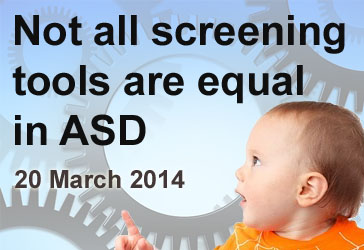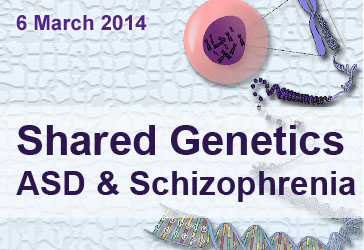Archives
March, 2014
Select a different month in the archive
CDC Reports ASD Rate Now 1 in 68
By Shana R. Spindler, Ph.D. on March 28, 2014

Background: Every few years, the United States Centers for Disease Control and Prevention (CDC) monitors the rate of Autism Spectrum Disorder (ASD) across the country. Participants in the CDC-funded Autism and Developmental Disabilities Monitoring (ADDM) Network collect data on 8-year-old children from a sampling of United States communities. In 2007, they published their first report, which showed that about 1 in 150 children had ASD. Since then, the rate has made a steady climb. In 2009, the number rose to 1 in 110. This was followed by 1 in 88 with ASD in the 2012 report.
What’s New: The CDC now reports that approximately 1 in 68 children in the United States have some form of ASD. The rate of ASD varies by community, with rates as low as 1 in 175 children in Alabama, contrasted to 1 in 45 in New Jersey. Of note, nearly half of the children with ASD had average or above average intellectual ability (IQ greater than 85), as compared to only 32 percent in 2002.
Why it’s important: Population-based studies are an important component of estimating ASD rates. It’s difficult to pinpoint why ASD rates are steadily increasing in the United States. Several factors may be at work, such as better detection methods, increased autism awareness, or environmental influences.
Help me understand :
| Source(s) : |
| Tweet |
Disorder-Specific Screening Catches More ASD Cases
By Chelsea E. Toledo, M.A. on March 20, 2014

Background: The American Academy of Pediatrics recommends that physicians screen all children for autism spectrum disorder (ASD) beginning at 18 months of age (http://www.cdc.gov/ncbddd/autism/hcp-recommendations.html). However, while most pediatricians routinely administer tests for a broad spectrum of developmental disorders, very few report that they screen specifically for ASD.
What’s New: The February 2014 issue of the journal Autism presents a study (originally published online December 21, 2012), comparing the ability of two types of screening tools to detect ASD in young children. The researchers evaluated 52 children between 18 and 24 months of age, using the Parents Evaluation of Developmental Status (PEDS) and Modified Checklist for Autism in Toddlers (MCHAT), as well as the updated M-CHAT with follow-up interview (M-CHAT+FUI). All participants then underwent diagnostic evaluation, resulting in 30 ASD diagnoses. While the broad PEDS screening caught 17 of those cases, the M-CHAT and M-CHAT+FUI detected 28 and 27, respectively.
Why it’s important: From the results, the researchers concluded that a combination of broad and disorder-specific screenings provide optimum detection of ASD cases, allowing for early intervention for those children ultimately diagnosed with ASD. However, with the release of the Diagnostic and Statistical Manual of Mental Disorders-Fifth Edition in May 2013, the diagnostic criteria for ASD shifted. Future studies will need to address how the new requirements for ASD affect the success of screening tools.
Help me understand :
| Source(s) : |
| Tweet |
Shared Genetics: ASD and Schizophrenia
By Eric Larsen, Ph.D. on March 6, 2014

Background: New high-throughput sequencing technologies are providing unprecedented view of the human genome. Exome sequencing—a method targeting the protein-coding part of the genome—is increasingly used to unravel genetic underpinnings of common, complex disorders such as autism and schizophrenia.
What’s new: In the February 13, 2014, issue of Nature, two studies reported mutations identified in exomes of large cohorts of individuals with schizophrenia and a control population. The first study analyzed rare, disruptive mutations in the protein-coding regions of approximately 2,500 genes previously implicated in schizophrenia. The team evaluated DNA of 2,536 schizophrenia cases and 2,543 healthy individuals. The second study analyzed the exomes of 600 schizophrenia trios (affected individuals along with their parents). Both studies found mutations distributed across many genes; many of these genes share function at the neuronal synapse—where two neurons communicate. Of particular importance, the authors demonstrated that the schizophrenia-associated genes identified in their studies overlapped with autism-associated genes.
Why it’s important: These findings illustrate that many rare mutations contribute to schizophrenia. Furthermore, genes enriched in a number of critical cellular pathways active at the neuronal synapse are preferentially targeted by rare disruptive mutations in schizophrenia. A shared genetic architecture between schizophrenia and other neurodevelopmental disorders is becoming evident.
Help me understand :
| Source(s) : |
| Tweet |

